Hormones are critical chemical messengers in our body responsible for regulating many body functions and metabolic processes.
Hormones can work synergistically together to promote certain function in our body and yet they can also work antagonistically (i.e., against) one another to establish certain check-and-balance.
Excess and deficiency of a hormone can wreak havoc to our body functions and health, and manifest into various symptoms.
Some of the common hormonal imbalance includes:
- Elevated or depressed cortisol (i.e., the stress hormone) levels, or disrupted circadian (or daily) pattern of cortisol.
- Elevated or depressed thyroid hormone levels.
- Excess or deficiency of sex hormones, in particular estrogen, progesterone and testosterone.
Let’s find out more if your symptoms may be related to imbalance of some of these hormones.
For the month of April, I am offering a complimentary hormone test kit (the DUTCH COMPLETE test – https://www.dutchtest.com/) and consultation, over $350 in value, if you sign-up for one of my coaching packages. To find out more, please book a free, no obligation discovery call with me here:
Cortisol, The Stress Hormone
Cortisol is secreted by the adrenal glands, the small glands above the kidneys. Cortisol prepares the body for ‘fight-or-flight’ response when stress is encountered.
Cortisol also works with melatonin (the sleep hormone) to regulate our sleep-wake cycle.
Chronic stress is the major contributor to cortisol imbalance. Stressors to our body are not only mental/psychological in origin, but also include physical/biomechanical stressors and internal biochemical/physiological stressors.
Some of the common stressors affecting our health include mental and emotional stress, physical injuries/trauma, over-exercise, sleep deprivation and irregular sleep hours, inappropriate diets, infections, chronic inflammation and environmental toxins.
Find out more about the roles of cortisol and how stress and cortisol imbalance affect our health in Why Stress is the Culprit.
Cortisol imbalance can be manifested into chronically elevated or depressed cortisol levels, or disrupted circadian cortisol pattern.
High Cortisol Levels
Some of the symptoms associated with chronically elevated cortisol levels are shown below.
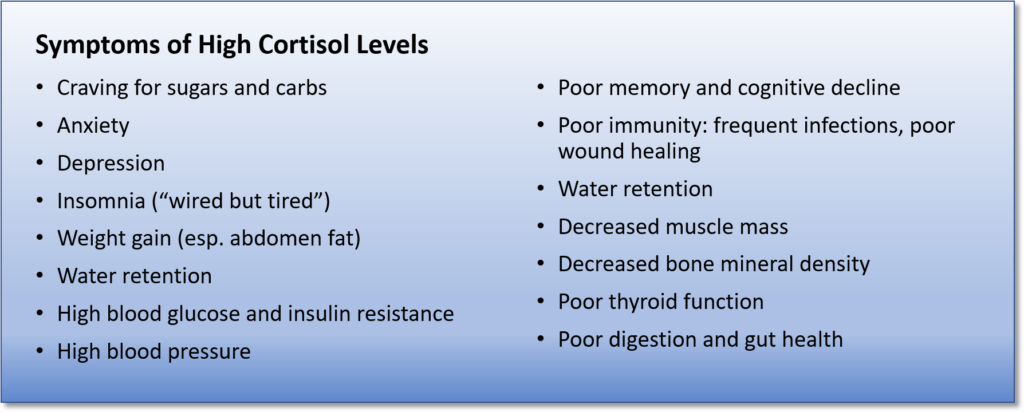
Low Cortisol Levels
Some of the symptoms associated with chronically depressed cortisol levels are shown below.
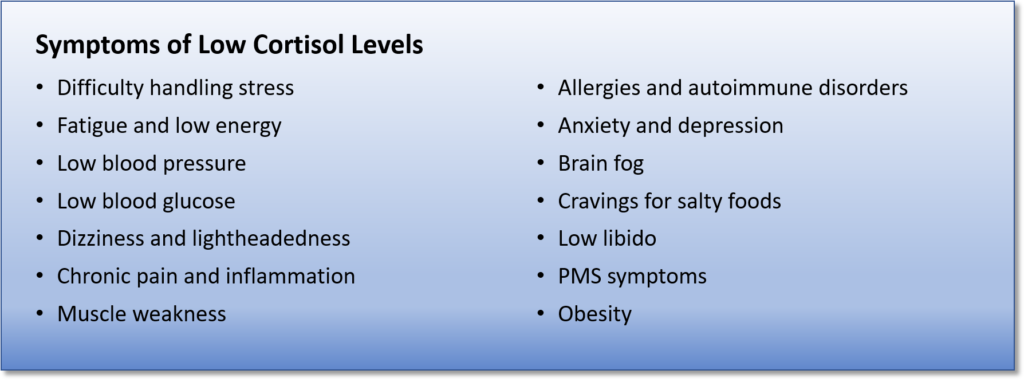
Disrupted Circadian Cortisol Pattern
Cortisol levels follow a circadian pattern (see Figure 1 below). Cortisol levels are the highest upon awake in the morning preparing the body for the daily tasks.
Cortisol levels continue to decline throughout the day and is the lowest at bed time, preparing the body for rest.
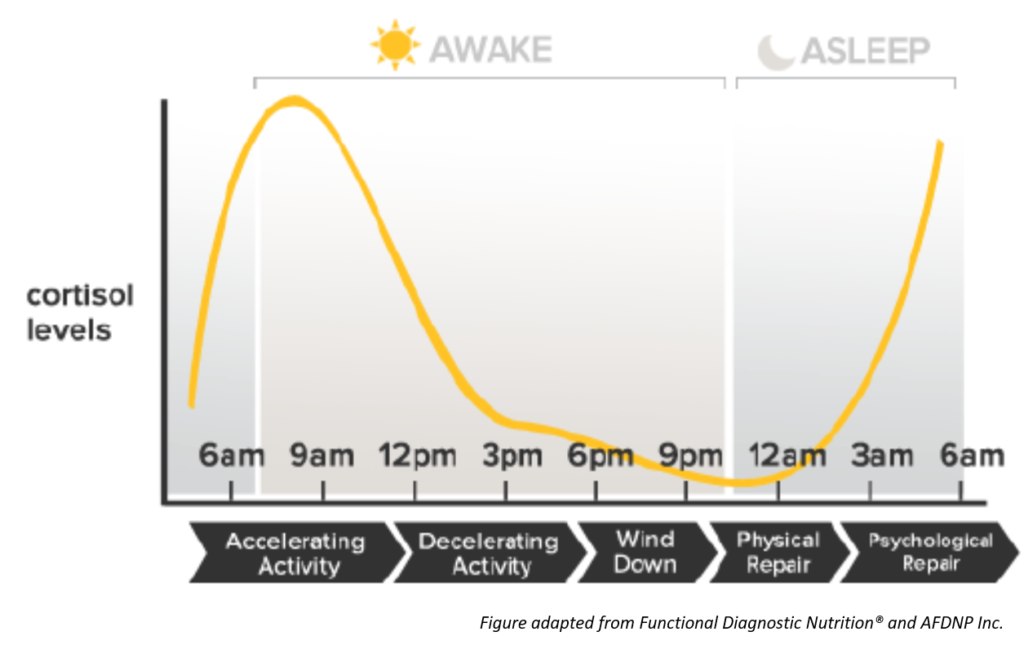
Figure 1. Circadian Pattern of Cortisol
Some of the symptoms associated with disrupted circadian cortisol pattern are shown below.

Thyroid Hormone
Thyroid hormone is the major metabolic hormone of the body and affects virtually every cell in the body. Some of the major functions of thyroid hormone include:
- Increases the basal metabolic rate (BMR) of the body.
- Promotes heat production.
- Regulates tissue growth and development especially critical for normal skeletal, muscular, nervous system and reproductive organ development during growth period.
- Maintains blood pressure.
Many factors can contribute to thyroid hormone imbalance including chronic stress, cortisol imbalance, sex hormone imbalance, and autoimmune disorders.
Thyroid hormone imbalance can be manifested into chronically elevated or depressed thyroid hormone levels, i.e. hyperthyroidism or hypothyroidism respectively.
Hypothyroidism
Hypothyroidism can be due to an autoimmune disorder called Hashimoto’s thyroiditis (HT), wherein the body’s own immune system attacks and damages the thyroid gland.
Hypothyroidism can also be due to thyroid gland dysfunction and iodine deficiency. More commonly, subclinical hypothyroidism is contributed by other secondary factors including chronic stress, elevated cortisol levels, elevated estrogen levels, liver dysfunction, gut flora imbalance and gut dysfunction, nutrient deficiency, and environmental toxins.1–5
Some of the symptoms associated with hypothyroidism are shown below.6
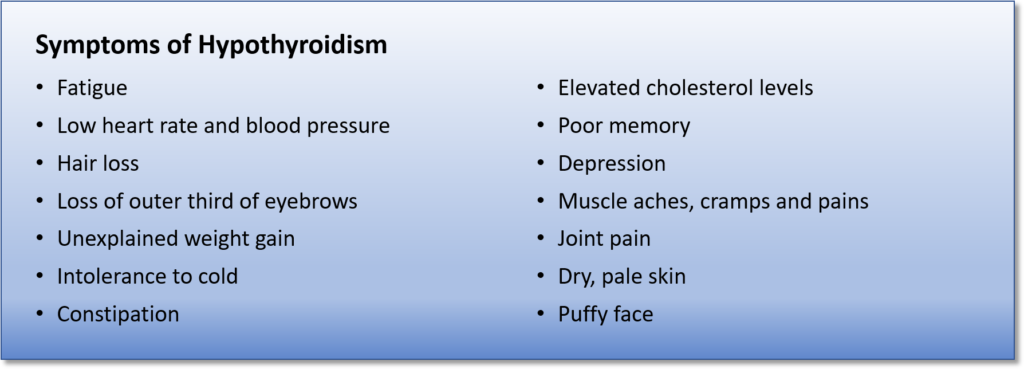
Hyperthyroidism
The most common cause of hyperthyroidism is an autoimmune disorder called Graves’ disease, wherein the body’s own immune system produces abnormal antibodies that stimulates thyroid hormone secretion.
Some of the symptoms associated with hyperthyroidism are shown below.6

Sex Hormones
Estrogen and progesterone are two major female sex hormones while testosterone is the major male sex hormones. All these hormones are present in both females and males and imbalance of any of these hormones can contribute to certain health conditions and symptoms.
Estrogen and Progesterone
The two main manifestations of estrogen and progesterone imbalance in women are estrogen excess or dominance (i.e., relatively high estrogen over progesterone levels) and estrogen deficiency.
There are many contributing factors to estrogen excess/dominance and estrogen deficiency including chronic stress, inflammation, xenoestrogen exposure, insulin resistance, liver dysfunction, menopause, etc.
For more details on the roles of estrogen and progesterone, and contributing factors to their imbalance, please check out my article on Female Hormonal Health – The Fine Balance.
Estrogen Excess/Dominance
Some of the symptoms associated with estrogen excess/dominance are shown below.
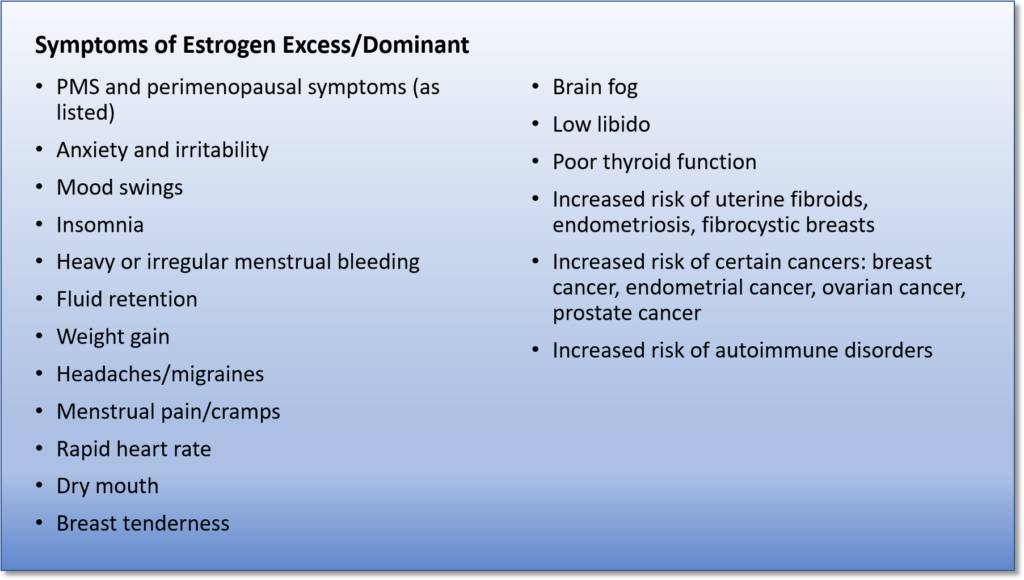
Estrogen Deficiency
Some of the symptoms associated with estrogen deficiency are shown below.
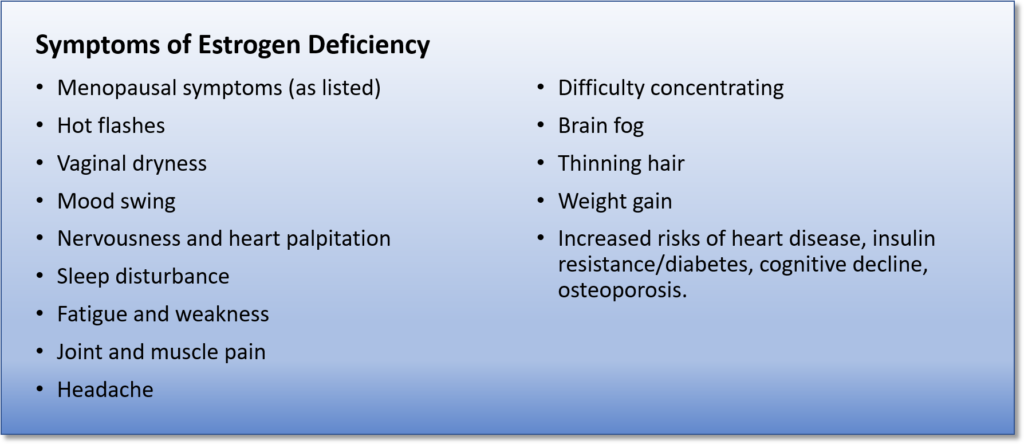
Progesterone Imbalance
In addition, estrogen levels can be normal, but progesterone level itself can be high or low. Symptoms associated with low progesterone levels are similar to those of estrogen excess/dominance.
Some of the symptoms associated with high progesterone levels are shown below.

Testosterone
In men, testosterone plays critical and analogous roles as estrogen in women. The major functions of testosterone include male reproductive function, and maintaining muscle mass and strength, bone mineral density, cardiovascular health and cognitive function.7
The two main manifestations of testosterone imbalance are excess and deficiency of testosterone, which can occur in both men and women although the reference ranges are different.
Low Testosterone
Aside from primary factors related to sexual organ dysfunction, there are many secondary contributing factors to low testosterone, including excess estrogen synthesis in the body, exposure to xenoestrogens in the environment and foods, blood sugar dysregulation, obesity, high blood pressure, chronic stress and cortisol imbalance, oxidative stress and inflammation, deficiency of certain nutrients (e.g. zinc, folate vitamins, B6, D, K), liver dysfunction, etc.7–10
Some of the symptoms associated with low testosterone levels are shown below.
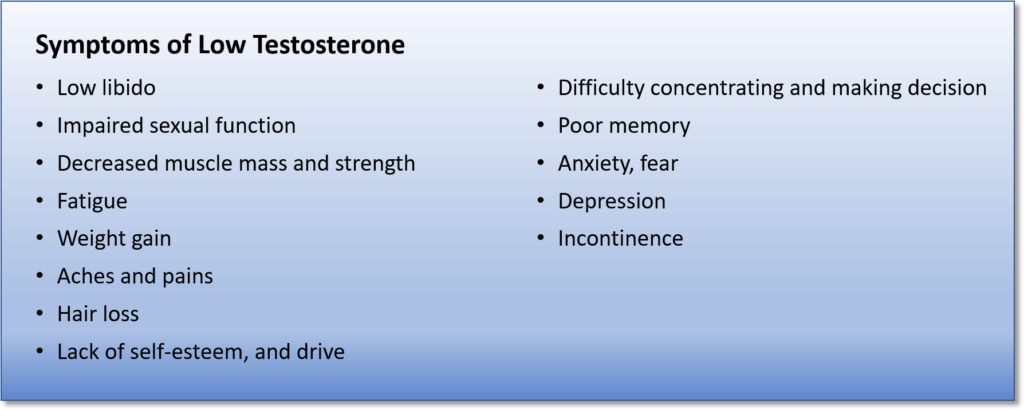
For men, estrogen dominance is reflected in relative high estrogen-to-testosterone ratio.11 Some of the associated symptoms are shown below.

High Testosterone
Testosterone levels can also be too high in both men and women. Contributing factors to high testosterone levels include blood glucose dysregulation and insulin resistance, polycystic ovarian syndrome (PCOS) in women, chronic stress and cortisol imbalance, inflammation, and liver and detox dysfunction.12,13
Some of the symptoms associated with high testosterone levels are shown below.

Summary: How to Restore Hormonal Balance?
Hormonal imbalance can manifest into various symptoms as described above. Imbalance of one hormone can also have cascading effects on other hormones.
For example, cortisol imbalance can contribute to estrogen and testosterone imbalance, which in turn can contribute to thyroid hormone imbalance. Thyroid hormone imbalance can also contribute to estrogen and testosterone imbalance.
Therefore, hormonal imbalance can form a vicious cycle.
It is important to note that hormonal imbalance and associated symptoms are not the roots of the problem but merely signs and manifestations of some underlying dysfunctions in the body (e.g. hidden stressors, chronic inflammation, liver/detox dysfunction, gut dysfunction, blood glucose dysregulation, insulin resistance, etc.).
Instead of chasing after symptoms and signs of hormonal imbalance, the goal should be to identify and address the underlying dysfunctions in the body. Functional Health Coaching can help to uncover the hidden stressors and underlying dysfunctions in the body and provide the body with what it needs to restore balance. Find out more here.
For the month of April, I am offering a complimentary hormone test kit (the DUTCH COMPLETE test – https://www.dutchtest.com/) and consultation, over $350 in value, if you sign-up for one of my coaching packages. To find out more, please book a free, no obligation discovery call with me here:
Related Articles
Female Hormonal Health – The Fine Balance
References
- Tahboub R, Arafah B. Sex steroids and the thyroid. Best Practice & Research Clinical Endocrinology & Metabolism. 2009;23(6):769-780. doi:10.1016/j.beem.2009.06.005
- Edwards L, Heyman A, Swidan S. Hypocortisolism: An evidence-based review. Integrative Medicine A Clinician’s Journal.2011;10(4): 30-37.
- Haugen B. Drugs that suppress TSH or cause central hypothyroidism. Best Practice & Research Clinical Endocrinology & Metabolism. 2009;23(6):793-800. doi:10.1016/j.beem.2009.08.003
- Zhang J, Huang J, Aximujiang K et al. Thyroid Dysfunction, Neurological Disorder and Immunosuppression as the Consequences of Long-term Combined Stress. Sci Rep. 2018;8(1). doi:10.1038/s41598-018-19564-y
- Prior J. The endocrinology of perimenopause need for a paradigm shift. Frontiers in Bioscience. 2011;S3(2):474-486. doi:10.2741/s166
- Marieb E, Hoehn K. Human Anatomy & Physiology (10th ed). San Francisco, CA: Pearson Benjamin Cummings; 2016
- McBride JA, Carson CC, Coward RM. Diagnosis and management of testosterone deficiency. Asian J Androl. 2014;17(2):177-86.
- McBride JA, Carson CC, Coward RM. Testosterone deficiency in the aging male. Ther Adv Urol. 2016;8(1):47-60.
- SpectraCell Laboratories. Testosterone. Spectracell.com. https://www.spectracell.com/media/uploaded/3/0e2676617_1385406470_392testosterone-wheel1113.pdf. Published 2013.
- Grossmann M, Matsumoto AM. A Perspective on Middle-Aged and Older Men With Functional Hypogonadism: Focus on Holistic Management. J Clin Endocrinol Metab. 2017;102(3):1067-1075.
- Goldstein S. Estrogen Dominance in Men. Naturopathic Doctor News and Review. https://ndnr.com/mens-health/estrogen-dominance-in-men/. Published 2018.
- Abdel-Rahman M. Androgen Excess. Emedicine.medscape.com. https://emedicine.medscape.com/article/273153-overview. Published 2018.
- Lizneva D, Gavrilova-Jordan L, Walker W, Azziz R. Androgen excess: Investigations and management. Best Practice & Research Clinical Obstetrics & Gynaecology. 2016;37:98-118. doi:10.1016/j.bpobgyn.2016.05.003

